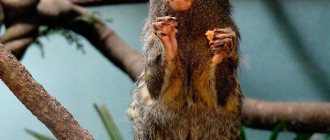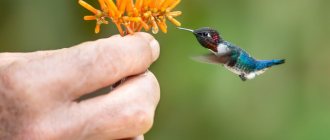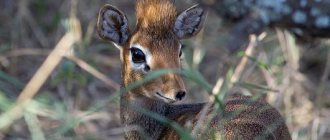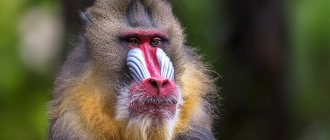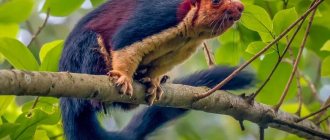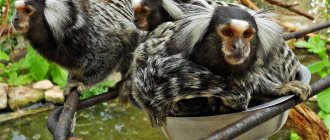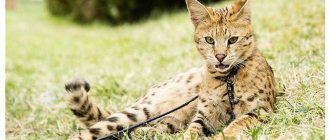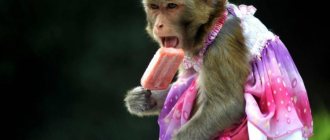- Wild animals
- >>
- Mammals
The marmoset is a small species of New World monkey native to the Amazon rainforest. This monkey is famous for being one of the smallest primates in the world, weighing just over 100 grams. The name “marmoset” perfectly suits this charming baby, which really resembles a miniature, but very mobile fluffy toy. If you want to learn more, check out this publication.
Origin of the species and description
Photo: Igrunka
Pygmy marmosets are considered to be somewhat different from other marmosets, most of which are classified in the genera Callithrix + Mico, and thus belong to their own genus, Cebuella, in the family Callitrichidae. There is debate among primatologists regarding the correct genus classification into which the marmoset should be placed. A study of the interstitial retinol binding protein nuclear gene in 3 species of marmosets showed that the time of separation of the pygmy, silvery and common marmosets from each other occurred less than 5 million years ago, which would be quite logical for species included in the same genus.
Video: Marmoset
However, the subsequent division of the silver marmoset (C. argentata) and the common marmoset (C. jacchus) into species groups allowed them to be placed in different genera (the argentata group was transferred to the genus Mico), which justifies the retention of a separate genus for pygmy marmosets, as as Callithrix is no longer a paraphyletic group. Morphological and molecular studies have prompted continued debate as to whether pygmy marmosets rightfully belong to Callithrix or Cebuella.
There are two subspecies of C. pygmaea:
- Cebuella pygmaea pygmaea - north/western marmoset;
- Cebuella pygmaea niveiventris - eastern marmoset.
There is little morphological difference between these subspecies, as they may vary only slightly in color and are separated only by geographic barriers, including major rivers in Central and South America. The evolution of this species differed in body weight from typical representatives of primates, since the animal had a high rate of decrease in body weight. This includes a significant reduction in intrauterine and postnatal growth rates, which suggests that progenesis had an important role in the evolution of this animal.
What is the pygmy marmoset's favorite dish?
These small primates readily eat fruits, insects, lizards, and bird eggs. Occasionally they hunt small birds. Whenever possible, the monkeys even enjoy honey. But still, their favorite dish is gum. They get it very simply: they climb a tree and make a small hole in its bark using their sharp teeth. To protect itself from unexpected damage, the tree begins to secrete sap, which the pygmy marmosets feed on. They can stay on the tree for a long time until they drink it completely.
Appearance and features
Photo: Marmoset monkey
The marmoset is one of the smallest primates in the world, with a body length ranging from 117 to 152 mm and a tail ranging from 172 to 229 mm. The average weight of an adult is just over 100 grams. The fur color is a mixture of brown, green, gold, gray and black on the back and head and yellow, orange and brown on the underside. The monkey has black rings on its tail, white spots on its cheeks, and a white vertical line between its eyes.
The cubs initially have gray heads and yellow bodies, long hairs covered with black stripes. Their adult pattern appears during the first month of life. Although pygmy marigolds are not considered sexually dimorphic, females can be slightly heavier than males. Longer hair around the face and neck gives the appearance of a lion-like mane.
Fun Fact: The marmoset has many adaptations for living in trees, including the ability to turn its head 180° and sharp claws used to cling to branches.
The monkey's teeth have special incisors that are adapted for making holes in trees and stimulating the flow of juices. The pygmy marmoset walks on all four limbs and can jump up to 5 m between branches. The similar eastern and western subspecies are difficult to differentiate, but sometimes have different ventral hair colors.
Kinds
The population of primates belonging to the marmoset family has become widespread due to active reproduction. 40 species are officially registered. But biologists and conservationists are sounding the alarm, calling on hunters to save mammals from the dwarf genus from extermination. Their high price played a negative role. Monkeys are caught not only for zoos or nurseries, but also for home keeping.
The marmoset attracted particular attention :
- common or white-eared;
- dwarf - aka marmoset;
- lion's
Every species deserves protection from ecologists and conservation organizations. Miniature marmosets are smart, friendly, and easy to train. The muzzle is painted with white stripes imitating a mustache. The long coat is impressive and mane-like.
The monkey actively turns its head in all directions; it has only 2 teeth in the form of protruding incisors. The length of the hind legs is longer than the front ones, it pushes off with its limbs and jumps high, and tenaciously holds on to the tree trunk with its claws.
Primates belong to the broad-nosed infraorder because they have an expanded nasal septum with everted nostrils. Usually the colony grows to 16 members, where the parents in the pair dominate; scientists emphasize stable nepotism.
The white-eared marmoset is similar in size to a squirrel. The animal quickly gets excited, screams loudly, if frightened, it jumps sharply away from a dangerous place. Active temperament begins in the early morning, when the sun sets, the flock returns to the roosting site. Large individuals also belong to the marmoset family. They are real beauties, their nature has rewarded them with:
- silky coat;
- long tail;
- rich mane;
- expressiveness;
- colorfulness.
Lion marmosets first described by a monk traveler. He compared them to ape-like cats that resemble lion cubs. Not correctly, but accurately, the Jesuit conveyed his impression of bright, temperamental creatures.
In the photo there is a lion marmoset
For their abundant fur, the monkeys received an exotic name in the zoological classification. Their long hair, like that of the king of beasts, luxuriantly covers the entire head, even hanging from the cheeks. Only a small area on the flat muzzle remains unovergrown. The animals weigh 700 grams and grow up to 77 cm, measured from the top of the head to the tip of the tail.
Where does the marmoset live?
Photo: Marmoset in nature
The marmoset, known as the pygmy marmoset, is a species of New World monkey. The marmoset's range extends through the Andean foothills of southern Colombia and southeastern Peru, then east through northern Bolivia to the Amazon basin in Brazil.
Marmosets can be found throughout much of the western Amazon basin, including:
- Peru;
- Brazil;
- Ecuador;
- Colombia;
- Bolivia.
The western marmoset (C. p. pygmaea) is found in the state of Amazonas, Brazil, Peru, southern Colombia and northeastern Ecuador. And the eastern pygmy marmoset (C. p. niveiventris) is also found in Amazonas, and also in Acre, Brazil, eastern Peru and Bolivia. The distribution of both subspecies is often limited to rivers. Typically, the marmoset lives in mature evergreen forests, near rivers and in flood-inundated jungles. Igrunyas spend most of the day in the trees and do not often go down to the ground.
Population density correlates with food supplies. The monkey can be found between ground level and no higher than 20 meters in the trees. They generally do not rise to the top of the canopy. Marmosets are often found in areas with standing water. They thrive in stratified riparian forests at lower elevations. In addition, monkeys were observed living in secondary forests.
Now you know where the pygmy marmoset monkey lives. Let's find out what she eats.
Reproduction
The female gives birth once, maximum twice a year, regardless of the season. It is not just the mother who raises the baby, but the entire flock. The optimal number of nannies for one cub is 5 individuals. Most of the time, the father, alternating with the other caregivers, carries him on their backs for protection from predators. The female’s responsibilities include exclusively breastfeeding and restoring her own strength.
Babies are born with fur different from their parents. On the body it is lemon yellow with a black marking on the outside, and the head is dark gray with yellow edging around the ears. After a month, complete molting occurs and a permanent adult coat appears.
The smallest monkey in the world is the Pygmy Marmoset
What does a marmoset eat?
Photo: Pygmy marmoset
The monkey feeds mainly on cud, sap, resin and other secretions from trees. Specialized, elongated lower incisors allow the igren to drill an almost perfectly round hole into a tree trunk or vine. When the juice begins to flow out of the hole, the monkey catches it with its tongue.
Most groups exhibit typical eating patterns. Since the oldest holes created by monkeys in a tree are the lowest, it can be assumed that they move up the tree trunk, creating new holes, until the tree no longer produces enough liquid secretions. The group then moves to a new feeding source.
The most common marmoset foods include:
- chewing gum;
- juice;
- resin;
- latex;
- spiders;
- grasshoppers;
- butterflies;
- fruits,
- flowers;
- small lizards.
Observations of wild marmoset populations have shown that they do not select plants at random. Animals tend to select species with the greatest amount of exudate in their home range. Exudate is any material that is released from a plant. Insects, especially grasshoppers, are a welcome source of food after exudates.
The marmoset also lies in wait for insects, especially butterflies, which are attracted by the juice from the holes. In addition, the monkey supplements its diet with nectar and fruits. The home range of the group is 0.1 to 0.4 hectares, and feeding is usually concentrated on one or two trees at a time. Tamarins often raid holes made by marmosets to feast on plant juices.
Male and female marmosets show differences in foraging and feeding behavior, although male and female dominance and aggressive behavior vary among species. Males have less time to search for food sources and feed due to the responsibilities of caring for the infant and being vigilant for predators.
Nutrition
The diet of small creatures is not particularly diverse. They absorb everything to saturate the body with nutrients and essential vitamins. There is enough calcium in greens, juices, and resins to strengthen bones.
Vitamins come from plant foods:
- latex;
- seeds;
- root vegetables;
- inflorescences;
- nectaries;
- mycelium.
Protein and fats come through:
- grasshoppers;
- larvae;
- not large lizards;
- frogs;
- eggs.
You need to constantly fight for food items in the wild in order to get ahead of:
- birds;
- parrots;
- toucans;
- possums.
In the wild, marmosets eat everything that attracts them, what they are used to and were able to get. When a marmoset is kept as a pet , taking care of its diet is the responsibility of the breeder. You can complete the food package in different ways, as long as it is edible and healthy. The main menu consists of:
- fruit;
- vegetables;
- insects;
- snails
Miniature creatures quickly get used to their owner and the people who care for them. They do not refuse chicken meat, boiled eggs, cottage cheese, milk, sprouted wheat.
A special treat for marmosets is the resinous secretions of trees.
Features of character and lifestyle
Photo: Common marmoset
About 83% of the marmoset population lives in stable units of two to nine individuals, including a dominant male, a breeding female, and up to four offspring. Although groups primarily include only family members, some structures may also include one or two additional adult members. The marmoset monkey is diurnal. Individuals groom each other, demonstrating a special form of communication.
But along with these friendly interactions, these monkeys are also very territorial animals, using scent glands to mark territories of up to 40 km2. They choose sleeping areas in close proximity to a feeding source, and all members of the group wake up and go out in search of food shortly after sunrise. Social activity is noticeable between two peaks of feeding - one after waking up, and the second in the late afternoon.
Interesting fact: Group members communicate using a complex system involving vocal, chemical and visual signals. The three main ringing signals depend on the distance the sound must travel. These monkeys may also make visual displays when threatened or display dominance.
Chemical signaling using secretions from glands in the chest and chest and genital areas enables the female to indicate to the male when she is capable of breeding. Animals can cling to vertical surfaces with their sharp claws while feeding.
Communication
There is constant interaction between members of the same flock using sounds, chemical and visual signals. Interestingly, depending on the type of information being transmitted, sound signals vary from whistling and grinding to trills. And different combinations of certain elements indicate a specific message.
The smallest monkey in the world is the Pygmy Marmoset
Social structure and reproduction
Photo: Baby marmoset
Marmosets are considered monogamous partners. Dominant males aggressively maintained exclusive access to reproductive females. However, polyandry has been observed in groups with multiple males. Females show no visible external signs of ovulation, but studies of wild individuals have shown that females can communicate their reproductive status to males through olfactory signals or behavior. In marmosets, no correlation was found between the number of adult males and the number of offspring.
Female pygmy marmosets can give birth to 1 to 3 babies, but most often give birth to twins. Approximately 3 weeks after giving birth, females enter estrus, during which mating occurs. The duration of pregnancy is about 4.5 months, i.e. every 5-6 months a couple of new marmosets are born. Pygmy marmosets have an extremely cooperative infant-care system, but only one dominant female in a group produces offspring.
Fun fact: Newborns weigh approximately 16 grams. After nursing for approximately 3 months and reaching sexual maturity within a year to a year and a half, they reach their adult weight at approximately 2 years of age. Juveniles usually remain in their group until they have gone through two subsequent birth cycles. Siblings also participate in the care of infants.
A newborn requires a lot of attention, so involving more family members in care reduces the number of hours spent raising the offspring and also instills parenting skills. Group members, usually females, may even delay their own reproduction by stopping ovulation to care for the offspring of others in the group. The ideal number of caregivers for a baby marmoset is about five. Guardians are responsible for finding food for the infants and also help the father keep an eye out for potential predators.
Reproduction and lifespan
In the class of mammals from the marmoset family, there are no clear restrictions on the periods for mating games and mating. The female can go on a spree and give birth in any season. But only the mother, from whom a family group united into a colony originated, has the right to continue the race in it.
This behavior is an exception to the rule, and not a pattern where animals are able to organize their lives with mutual help. The entire family raises and cares for the children.
Females can adhere to monogamy and hang out with several males. The choice of partner is theirs when they reach full adulthood with reproduction at 2 years of age. When a young couple is formed, it is separated from its ancestors.
The mother carries the baby for 150 days. Twins or triplets are born immediately, each weighing 15 grams. It is interesting that there is a division of responsibilities here too. The newborn is cared for by females.
After reaching 2 months of age, the father joins in the upbringing. He carries the baby, cleans it, and only when it gets hungry returns it to its parent. After 3 months, the cub becomes completely self-sufficient. During this time, his parents will teach him how to get food, behave correctly, follow the rules and requirements of the colony, and obey his elders.
Primates of this species live in the wild for a maximum of 11 years. They are kept in home cages for 15 years thanks to proper care, veterinary examinations, and vaccinations, which prolong their life.
Natural enemies of marmosets
Photo: Marmosets
The yellow, green and brown pigments of marmosets provide them with camouflage in their forest habitat. In addition, monkeys have developed means of communication to warn each other about impending threats. However, their small body size makes them potential prey for birds of prey, small cats and climbing snakes.
Known predators that attack marmosets include:
- birds of prey (falconiformes);
- small cats (Felidae);
- tree-climbing snakes (Serpentes).
It appears that the biggest role these tiny primates play in their ecosystem is related to their basic feeding mechanism, so they may influence the health of the trees they feed on. Larger, competing primates that also feed on exudates may drive groups of smaller marmosets out of a tree to take advantage of previously drilled holes. With the exception of such interactions, contact between C. pygmaea and other primates generally occurs without complications.
Interesting Fact: Since the 1980s, marmosets have been heavily affected by Lymphocytic Choriomeningitis Virus (LCMV), carried by the common mouse, throughout North America. This has led to multiple fatal outbreaks of hepatitis (CH) among captive marmosets.
Ants can enter drilled holes in trees, so marmosets are forced to relocate. Pygmy marmosets are susceptible to the parasite Toxoplasma gondii, which results in fatal toxoplasmosis. There is limited data on the lifespan of wild marmosets, however, birds of prey, small cats and climbing snakes are common predators.
Why are pygmy marmosets called pocket lions?
It is believed that these tiny monkeys are the smallest primates. But scientists are in no hurry to confirm this point of view. Because the second candidate for this title is the dwarf mouse lemur. Some researchers believe that this particular animal is the smallest. And the dwarf marmoset takes only second place.
However, the body dimensions of this tiny creature are from 11 to 15 centimeters, and its weight is only 100-150 grams. The largest part of the body is the tail, the length of which is 17-22 centimeters. It performs a very important function as a balancer and allows the monkey to maintain balance. The tail is covered with thick fur, the color of which resembles black and gray rings.
Why are pygmy marmosets considered social animals?
These tiny creatures live in small groups that can be called full-fledged families. Each group includes several representatives of different generations. There are 3-4 adults, 2 teenagers and 2 kids.
Marmosets lead a very active lifestyle. During the day, they get their own food, take care of their growing offspring, and protect members of their group from various dangers and from strangers. At night, animals roost in tree hollows. This process is led by the most important male in the group.
Social relationships in such families are built through grooming - this is careful care of each other's fur. Games in which several family members take part are also an important process. Chasing and fighting are part of these games. Marmosets also love to play alone, that is, perform simple acrobatic tricks, jump, run, pretend to be chasing or hunting insects.
To protect their territory, marmosets mark it with special secretions from special glands. The marmosets notify other members of the group with sound signals about the appearance of an enemy. Strangers are always driven away by shouting. If this does not help, the marmosets fight with them.
